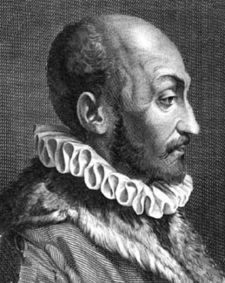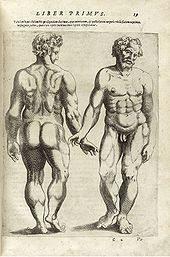- Giambattista della Porta
-
Giambattista della Porta 
Giambattista della Porta[1]Born late 1535
Vico Equense, ItalyDied 4 February 1615
Naples, ItalyResidence Naples Nationality Italy Fields Occult philosophy, astrology, alchemy, mathematics, meteorology, and natural philosophy Alma mater Self educated Giambattista della Porta (1535?[2] – 4 February 1615), also known as Giovanni Battista Della Porta and John Baptist Porta,[3] was an Italian scholar, polymath and playwright who lived in Naples at the time of the Scientific Revolution and Reformation.
Giambattista della Porta spent the majority of his life on scientific endeavors. He benefited from an informal education of tutors and visits from renowned scholars. His most famous work, first published in 1558, was entitled Magiae Naturalis (Natural Magic). In this book he covered a variety of the subjects he had investigated, including the study of: occult philosophy, astrology, alchemy, mathematics, meteorology, and natural philosophy. He was also referred to as "professor of secrets".[4]
Contents
Childhood
Giambattista della Porta was born at Vico Equense, near Naples, to the nobleman Nardo Antonio della Porta. He was the third of four sons, second to survive childhood. His childhood was privileged as he was able to receive the best education possible. His father, Nardo Antonio della Porta, had a thirst for learning, a trait he would pass onto all of his children. He surrounded himself amongst distinguished men and entertained the likes of philosophers, mathematicians, poets, and musicians. The atmosphere of the house resembled much of an academy for his sons. The learned circle of friends he enclosed himself in stimulated the boys as the visitors tutored and mentored them, under strict guidance of their father. He took an active interest in custom tailoring the education his boys would receive. Their education was extremely well rounded, surely moulding Giambattista into the Renaissance man that he was to become.
As well as being extremely gifted with an affinity for the sciences and mathematics, all the brothers were also extremely interested in the arts, music in particular. Despite their interest none of them possessed any sort of talent for it, but they did not allow that to stifle their progress in learning of theory. They were all accepted into the Scuola di Pitagora, a highly exclusive academy of musicians. Apparently the pure impressiveness of their intellect was enough to allow three tone-deaf mathematicians into a school for the musically gifted. The status of the family as a symbol of knowledge and intellectual growth surely helped in their acceptance as well.
More aware of their social position than the idea that his sons could have professions in science, Nardo Antonio was raising the boys more as gentlemen; very well rounded gentlemen at that. Therefore, the boys struggled with singing, as that was considered a courtly accomplishment of gentlemen. They were taught to dance, ride equestrian, to take part and perform well in tournaments and games, and dress well so they could look good doing all these noble activities. The training gave della Porta, at least earlier in his life, a taste for the finer aspects of his privileged living, where he surrounded himself in noble company and lavish things. This kind of lifestyle, the façade and showmanship involved in presenting one's self carried with Giambattista throughout his life.[5]
Scientific disciplines
In 1563, della Porta published De Furtivis Literarum Notis, a work about cryptography. In it he described the first known digraphic substitution cipher.[6]Charles J. Mendelsohn commented:[7]
He was, in my opinion, the outstanding cryptographer of the Renaissance. Some unknown who worked in a hidden room behind closed doors may possibly have surpassed him in general grasp of the subject, but among those whose work can be studied he towers like a giant.
In 1586 della Porta published a work on physiognomy, De humana physiognomonia libri IIII (1586).This influenced the Swiss 18th century pastor Johann Kaspar Lavater. Della Porta wrote extensively on a wide spectrum of subjects throughout his life – for instance, an agricultural encyclopædia entitled Villa, as well as works on meteorology, optics, and astronomy.
In later life, della Porta collected rare specimens and grew exotic plants. His work Phytognomonica lists plants according to their geographical location. In Phytognomonica the first observation of fungal spores is recorded, making him a pioneer of mycology.
His private museum was visited by travellers and was one the earliest examples of natural history museums. It inspired the Jesuit Athanasius Kircher to begin a similar, even more renowned, collection in Rome.
Pioneering scientific society
Della Porta was the founder of a scientific society called the Academia Secretorum Naturae (Accademia dei Segreti). This group was more commonly known as the Otiosi, (Men of Leisure). Founded sometime before 1580, the Otiosi were one of the first scientific societies in Europe and their aim was to study the "secrets of nature." Any person applying for membership had to demonstrate they had made a new discovery in the natural sciences.
The Academia Secretorum Naturae was compelled to disband when its members were suspected of dealing with the Occult. Della Porta was summoned to Rome by Pope Paul V. Though he personally emerged from the meeting unscathed, the Academia Secretorum Naturae disbanded. Despite this incident, della Porta remained religiously devout and became a lay Jesuit brother.
Della Porta joined The Academy of the Lynxes in 1610.[8][9]
Technological contributions
His interest in a variety of disciplines resulted in the technological advances of the following: agriculture, hydraulics, Military Engineering, instruments, and pharmacology. He published a book in 1606 on raising water by the force of the air. In 1608 he published a book on military engineering.
Additionally, della Porta perfected the camera obscura. In a later edition of his Natural Magic, della Porta described this device as having a convex lens. Though he was not the inventor, the popularity of this work helped spread knowledge of it. He compared the shape of the human eye to the lens in his camera obscura, and provided an easily understandable example of how light could bring images into the eye.
Della Porta also claimed to have invented the first telescope, but died while preparing the treatise (De telescopiis) in support of his claim. His efforts were also overshadowed by Galileo Galilei's improvement of the telescope in 1609, following its introduction in the Netherlands in 1608.
In the book, Porta also mentioned an imaginary device known as a sympathetic telegraph. The device consisted of two circular boxes, similar to compasses, each with a magnetic needle, supposed to be magnetized by the same lodestone. Each box was to be labeled with the 26 letters, instead of the usual directions. Porta assumed that this would coordinate the needles such that when a letter was dialed in one box, the needle in the other box would swing to point to the same letter, thereby helping in communicating.[4]
Religious complications
A Catholic, della Porta was examined by the Inquisition in the years prior to 1578. He was forced to disband his Academia Secretorum Naturae, and in 1592 his philosophical works were prohibited from further publication by the Church; the ban was lifted in 1598. Porta's involvement with the inquisition puzzles historians due his active participation in charitable Jesuit works by 1585. A possible explanation for this lies in Porta's personal relations with Fra Paolo Sarpi after 1579.
Playwright
The 17 theatrical works that have survived from a total of perhaps 21 or 23 works[10] comprise 14 comedies, one tragicomedy, one tragedy and one liturgical drama.
Although they belong to the lesser-known tradition of the commedia erudita rather than the commedia dell'arte - which means they were written out as entire scripts instead of being improvised from a scenario - della Porta's comedies are eminently performable. While there are obvious similarities between some of the characters in della Porta's comedies and the masks of the commedia dell'arte, it should be borne in mind that the characters of the commedia erudita are uniquely created by the text in which they appear, unlike the masks, which remain constant from one scenario to another. Indeed, the masks of the improvised theatre evolved as stylised versions of recurring character types in the written comedies. By the time Carlo Goldoni started writing new scripts in the 18th century, the "improvised" comedy had become tired and predictable.
Works
- Natural Magic 1558 expanded to 20 books 1589. English translation 1658. Available online at [1]
- De furtivis Literarum Notis (1563) On secret codes and Cryptography
- Villa (1583-92) An agricultural encyclopaedia
- De humana physiognomonia libri IIII (1586) On Physiognomy
- De refractione optices (1589) On Optics
- Elementorum curvilineorum libri duo (1601)
- Coelestis Physiogranonia (1603) pub. Naples
- De aeris transmutanionbus (1609) On Meteorology
- De distillatione (1610) Della Porta's chemical experiments and observations.
- De Miracoli & Maravigliosi Effetti dalla Natura prodotti (1665) pub. Venice
References
- ^ Portrait of della Porta: from Jo. Bapt. Portae Neapolitani Magiae naturalis libri XX...., Naples, 1589
- ^ The date of della Porta's birth is ambiguous due to mis-statements by della Porta himself, in which he claimed to have written Magiae naturalis at an incorrectly young age.
- ^ http://homepages.tscnet.com/omard1/jportat3.html
- ^ a b Salomon "Introduction" in Data Compression Handbook, p. 1
- ^ Louise Clubb, Giambattista Della Porta, Dramatist. Princeton: Princeton University Press, 1965
- ^ David Kahn, The Codebreakers, 1967, p. 139
- ^ Mendelsohn, Charles. Proceedings, American Philosophical Society (vol. 82, 1940). American Philosophical Society. p. 113. ISBN 9781422372241. http://books.google.com/books?id=wTgLAAAAIAAJ&pg=PA113.
- ^ COMMITTEE FOR THE NATIONAL IV CENTENNIAL OF THE FOUNDATION ACADEMY OF LINCEI - Federico Cesi
- ^ "The sharp-eyed lynx, outfoxed by nature: Galileo and friends taught us that there is more to observing than meets the eye - Column", Natural History, May, 1998 by Stephen Jay Gould
- ^ Louise Clubb, Giambattista Della Porta, Dramatist. Princeton: Princeton University Press, 1965, pp. 69 and 300–301
Sources
- Clubb, Louise George (1965) Giambattista Della Porta, Dramatist. Princeton: Princeton University Press.
- Arianna Borrelli: Giovan Battista Della Porta’s Neapolitan Magic & His Humanistic Meterology, in: Variantology 5. Neapolitain Affairs. (Cologne: Verlag der Buchhandlung Walther König, 2011) , ISBN 978-3-86560-887-1.
- Siegfried Zielinski: Deep Time of the Media. Toward an Archaeology of Hearing and Seeing by Technical Means (Cambridge, MA: MIT Press, 2008) , ISBN 978-0262740326.
External links
- O'Connor, John J.; Robertson, Edmund F., "Giambattista della Porta", MacTutor History of Mathematics archive, University of St Andrews, http://www-history.mcs.st-andrews.ac.uk/Biographies/Porta.html.
- della Porta's Life
- Giambattista della Porta: De humana physiognomonia libri IIII (Vico Equense, Italy, 1586). Selected pages scanned from the original work. Historical Anatomies on the Web. US National Library of Medicine.
- Burns, Paul The History of the Discovery of Cinematography An Illustrated Chronology
- Works by Giambattista della Porta at Project Gutenberg
- Works by or about Giambattista della Porta in libraries (WorldCat catalog)
Categories:- 1535 births
- 1615 deaths
- People from the Province of Naples
- Pre-19th-century cryptographers
- Italian scientists
- Italian astrologers
- Italian inventors
- Physiognomists
Wikimedia Foundation. 2010.

